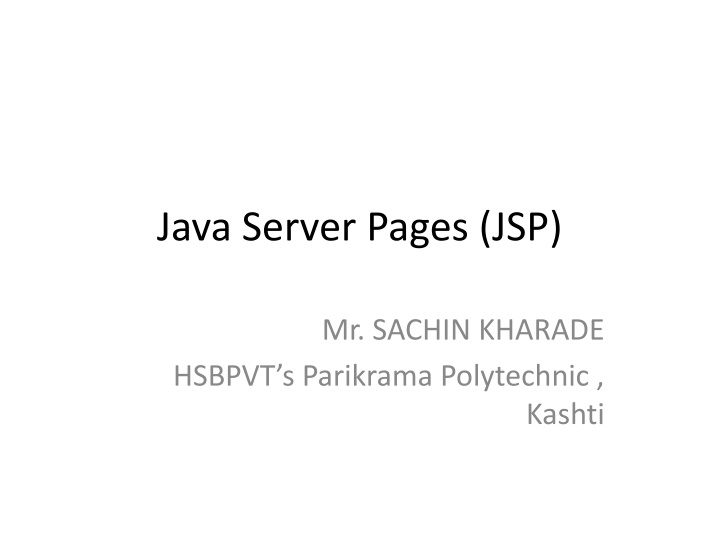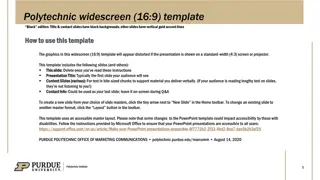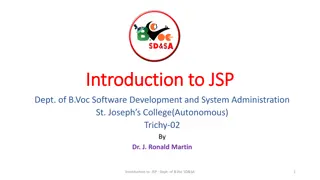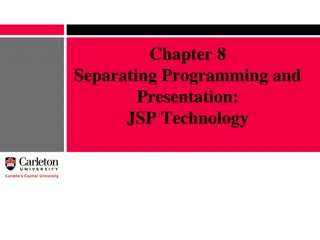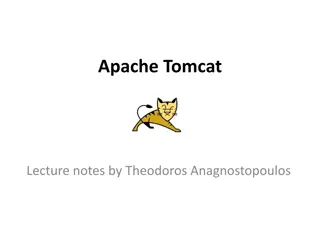Introduction to JSP Technology at Parikrama Polytechnic
JSP technology, an extension of Servlet, facilitates web application development with features like Expression Language and JSTL. Understand the life cycle of a JSP page, directives and declarations, and more at Parikrama Polytechnic, Kashti.
Download Presentation

Please find below an Image/Link to download the presentation.
The content on the website is provided AS IS for your information and personal use only. It may not be sold, licensed, or shared on other websites without obtaining consent from the author.If you encounter any issues during the download, it is possible that the publisher has removed the file from their server.
You are allowed to download the files provided on this website for personal or commercial use, subject to the condition that they are used lawfully. All files are the property of their respective owners.
The content on the website is provided AS IS for your information and personal use only. It may not be sold, licensed, or shared on other websites without obtaining consent from the author.
E N D
Presentation Transcript
Java Server Pages (JSP) Mr. SACHIN KHARADE HSBPVT s Parikrama Polytechnic , Kashti
Introduction JSP technology is used to create web application just like Servlet technology. It can be thought of as an extension to servlet because functionality than servlet such as expression language, jstl (JSP Standard Tag Library) etc. JSPs are server-side technology, the processing of both the static and dynamic elements. A JSP page consists of HTML tags and JSP tags. The jsp pages are easier to maintain than servlet because we can separate designing and development. It provides some additional features such as Expression Language, Custom Tag etc. it provides more
Life cycle of a JSP Page The steps in the life cycle of jsp page are: Translation Compilation Loading Instantiation Initialization RequestProcessing Destruction
Life cycle of JSP in more detail 1) Whenever container receives request from client, it does translation only when servlet class is older than JSP page otherwise it skips this phase. 2) Then the container compiles the corresponding servlet program Loads the corresponding servlet class Instantiates the servlet class Calls the jspInit() method to initialize the servlet instance( Jsp container will do this job only when the instance of servlet file is not running or if it is older than the jsp file.) [code language= java ] public void jspInit() { //code to intialize Servlet instances }[/code]
JSP directives& declarations Directives control the processing of an entire JSP page. It gives directions to the server regarding processing of a page. Syntax of Directives: <%@ directive name [attribute name= value attribute name= value ........]%> There are three types of Directives in JSP: 1) Page Directive 2) Include Directive 3) TagLib Directive
3) A new thread is then gets created, which invokes the_jspService() method, with a request (HttpServletRequest) and response (HttpServletRespnse) objects as parameters -shown below. [code language= java ] void _jspService( HttpServletRequest req, HttpServletResponse res) { //code goes here }[/code] 4) Invokes the jspDestroy() method to destroy the instance of the servlet class. code will look like below [code language= java ] public void jspDestory() { //code to remove the instances of servlet class }[/code]
1) Page Directive There are several attributes, which are used along with Page Directives and these are import-used to import packages. Syntax: <%@page import="value"%> Example: <%@page import="java.io.*%> Session- while building a user interactive JSP application, we make sure to give access to the user to get hold of his/her personal data till the session is active. Consider an example of logging in into your bank account, we can access all of your data till we signout (or session expires). In order to maintain session for a page the session attribute should be true. Syntax: <%@ page session="value"%> here value is either true OR false Example: <%@ page session="true"%>
isErrorPage- This attribute is used to specify whether the current JSP page can be used as an error page for another JSP page. Syntax : <%@ page isErrorPage="value"%> Here value is either true OR false. Example: <%@ page isErrorPage="true"%> errorPage- errorPage attribute is used to specify the URL of a JSP page which has isErrorPage attrbute set to true. It handles the un-handled exceptions in the page. Syntax : <%@ page errorPage="value"%> Here value is a JSP page name which has exception handling code (and isErrorPage set to true). Example : <%@ page errorPage="ExceptionHandling.jsp"%>
ContentType- This attribute is used to set the content type of a JSP page. Default value: text/html Syntax : <%@ page contentType="value"%> here value of content type can be anything such as: text/html, text/xml etc. Example: <%@ page contentType="text/html"%> for text/xml based pages: <%@ page contentType="text/xml"%> Buffer- This attribute is used to specify the buffer size. If you specify this to none during coding then the output would directly written to Response object by JSPWriter. And, if you specify a buffer size then the output first written to buffer then it will be available for response object. Syntax : <%@ page buffer="value"%>value is size in kb or none. Example: <%@ page buffer="none"%> 5 kb buffer size for the page, which has below code: <%@ page buffer="5kb"%>
extends- Like java, here also this attribute is used to extend(inherit) the class. Syntax:<%@ page extends="value"%> Value is package_name.class_name. Example: <%@ page extends= "mypackage.SampleClass"%> Info- It provides a description to a JSP page. The string specified in info will return when we will call getServletInfo() method. Syntax: <%@ page info="value"%> here value is Message or Description Example: <%@ page info= JSP page tag directives"%>
language- It specifies the scripting language ( underlying language) being used in the page. Syntax:<%@ page language="value"%> value is scripting language here. Example:<%@ page language="java"%> autoflush- If it is true it means the buffer should be flushed whenever it is full. false will throw an exception when buffer overflows. Default value: True Syntax:<%@ page autoFlush="value"%> value can be true or false. Example: <%@ page autoFlush="true"%> Buffer will be flushed out when it is full
2) Include Directive Include directive is used to copy the content of one JSP page to another. It s like including the code of one file into another. Syntax: <%@include file ="value"%> here value is the JSP file name which needs to be included. Example: <%@include file="myJSP.jsp"%> If the file is in the same directory then just specify the file name otherwise complete URL(or path) needs to be mentioned in the value field.
3) Taglib Directive This directive basically allows user to use Custom tags in JSP. Syntax : <%@taglib uri ="taglibURI" prefix="tag prefix"%> Where URI is uniform resource locator, which is used to identify the location of custom tag and tag prefix is a string which can identify the custom tag in the location identified by uri. Example : <%@ taglib uri="http://www.sample.com/mycustomlib" prefix="demotag" %> <html> <body> <demotag:welcome/> </body> </html>
JSP Expression Tag Expression placed in it, converts the result into String and send the result through response object. It writes the result to the client(browser). Syntax of expression tag in JSP: <%= expression %> tag evaluates the expression back to the client
Example 1: Expression of values Here we are simply passing the expression of values inside expression tag. <html> <head> <title>JSP expression tag example1</title> </head> <body> <%= 2+4*5 %> </body> </html>
Example 2: Expression of variables In this example we have initialized few variables and passed the expression of variables in the expression tag for result evaluation. <html> <head> <title>JSP expression tag example2</title> </head> <body> <% int a=10; int b=20; int c=30; %> <%= a+b+c %> </body> </html>
JSP Declaration tag Declaration tag is a block of java code for declaring class wide variables, methods and classes. Whatever placed inside these tags gets initialized during JSP initialization phase and has class scope. declaration tag can be used for defining class level variables, methods and classes. Syntax of declaration tag: <%! Declaration %>
Example 1: Variables declaration In this example we have declared two variables inside declaration tag and displayed them on client using expression tag. <html> <head> <title>Declaration tag Example1</title> </head> <body> <%! String name= Aksha"; %> <%! int age=8; %> <%= "Name is: "+ name %><br> <%= "AGE: "+ age %> </body> </html>
Example 2: Methods declaration In this example we have declared a method sum using JSP declaration tag. <html> <head> <title>Methods Declaration</title> </head> <body> <%! int sum(int num1, int num2, int num3) { return num1+num2+num3; } %> <%= "Result is: " + sum(10,40,50) %> </body> </html
JSP Custom tags User-defined tags are known as custom tags. To create a custom tag we need three things: 1) Tag handler class: In this class we specify what our custom tag will do when it is used in a JSP page. 2) TLD file: Tag descriptor file where we will specify our tag name, tag handler class and tag attributes. 3) JSP page: A JSP page where we will be using our custom tag.
Tag library descriptor (TLD) The custom tags can be implemented or redistributed with tag handlers that are written in Java. These redistributable tags must be in a library called Tag Library Descriptor. The TLD file is an XML file. It contains the information about the tag library and about detailed description in the library. TLDs are handled by the container and also by the development tools of JSP that is to validate the tags. The extension for the tag library file is .tld and must be packaged in the WEB-INF/ directory or in the /META-INF directory or subdirectory of the tag library packaged in a JAR file or subdirectory of the WAR file. The tag library will be automatically generated by the web container if the file is packaged in /WEB-INF/tags or in a subdirectory. A tag library file must begin with a root element taglib which specifies the schema and the JSP version. For Example: <taglib xmlns=http://java.sun.com/xml/ns/j2ee xmlns:xsi=http://www.w3.org/2001/XMLSchema-instance xsi:schemaLocation="http://java.sun.com/xml/ns/j2ee/web- jsptaglibrary_2_0.xsd" version= 2.0 >
JSTL JSP Standard Tag Library(JSTL) is a standard library of readymade tags. The JSTL contains several tags that can remove scriplet code from a JSP page by providing some ready to use, already implemented functionalities. common
JSTL is divided into 5 groups: JSTL Core: JSTL Core provides several core tags such as if, forEach, import, out etc to support some basic scripting task. Url to include JSTL Core Tag inside JSP page is <%@ taglib prefix="c" uri="http://java.sun.com/jsp/jstl/core" %> JSTL Formatting: JSTL Formatting library provides tags to format text, date, number for Internationalised web sites. Url to include JSTL Formatting Tags inside JSP page is <%@ taglib prefix="fmt" uri="http://java.sun.com/jsp/jstl/fmt" %>
JSTL sql: JSTL SQL library provides support for Relational Database Connection and tags to perform operations like insert, delete, update, select etc on SQL databases. Url to include JSTL SQL Tag inside JSP page is <%@ taglib prefix="sql" uri="http://java.sun.com/jsp/jstl/sql" %> JSTL XML: JSTL XML library provides support for XML processing. It provides flow control, transformation features etc. Url to include JSTL XML Tag inside JSP page is <%@ taglib prefix="x" uri="http://java.sun.com/jsp/jstl/xml" %>
JSTL functions: JSTL functions library provides support for string manipulation. Url to include JSTL Function Tag inside JSP page is <%@ taglib prefix="fn" uri="http://java.sun.com/jsp/jstl/functions" %>
JSTL Core Library The JSTL core library contains several tags that can be used to eliminate the basic scripting overhead such as for loop, if...else conditions etc from a JSP Page. Let's study some important tags of JSTL Core library.
JSTL if tag: The if tag is a conditional tag used to evaluate conditional expressions. When a body is supplied with if tag, the body is evaluated only when the expression is true. For Example : <%@ taglib uri="http://java.sun.com/jsp/jstl/core" prefix="c" %> <html> <head> <title>Tag Example</title> </head> <body> <c:if test="${param.name == 'studytonight'}"> <p>Welcome to ${param.name} </p> </c:if> </body> </html>
JSTL out tag: The out tag is used to evaluate an expression and write the result to JspWriter. For Example : <%@ taglib uri="http://java.sun.com/jsp/jstl/core" prefix="c" %> <html> <head> <title>Tag Example</title> </head> <body> <c:out value="${param.name}" default="StudyTonight" /> </body> </html> The value attribute specifies the expression to be written to the JspWriter. The default attribute specifies the value to be written if the expression evaluates null.
JSTL forEach tag: This tag provides a mechanism for iteration within a JSP page. JSTL forEach tag works similarly to enhanced for loop of Java Technology. You can use this tag to iterate over an existing collection of items. For Example : <%@ taglib uri="http://java.sun.com/jsp/jstl/core" prefix="c" %> <html> <head> <title>Tag Example</title> </head> <body> <c:forEach var="message" items="${errorMsgs}" > <li>${message}</li> </c:forEach> </body> </html>
JSTL catch tag: The JSTL catch tag is used to handle exception and doesn't forward the page to the error page. For Example : <%@ taglib uri="http://java.sun.com/jsp/jstl/core" prefix="c" %> <html> <head> <title>Tag Example</title> </head> <body> <c:catch> <% int a = 0; int b = 10; int c = b/a; %> </c:catch> </body> </html>
